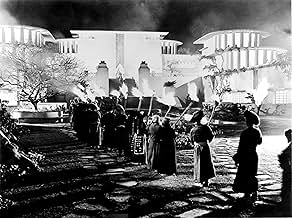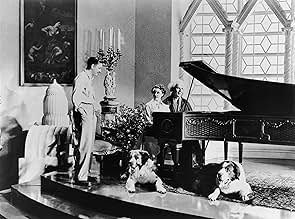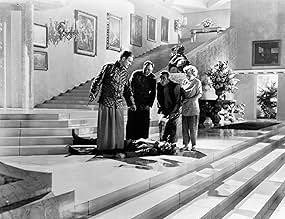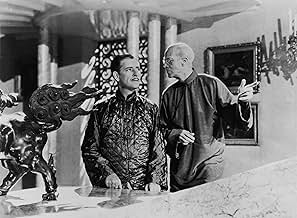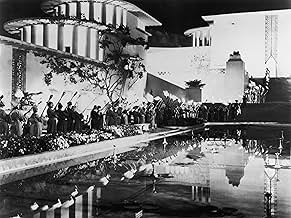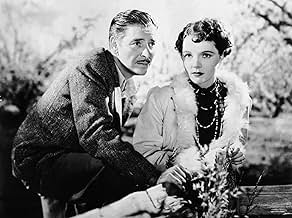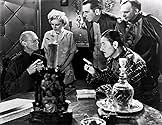IMDb RATING
7.6/10
15K
YOUR RATING
When a revered diplomat's plane is diverted and crashes in the peaks of Tibet, he and the other survivors are guided to an isolated monastery at Shangri-La, where they wrestle with the invit... Read allWhen a revered diplomat's plane is diverted and crashes in the peaks of Tibet, he and the other survivors are guided to an isolated monastery at Shangri-La, where they wrestle with the invitation to stay.When a revered diplomat's plane is diverted and crashes in the peaks of Tibet, he and the other survivors are guided to an isolated monastery at Shangri-La, where they wrestle with the invitation to stay.
- Director
- Writers
- Stars
- Won 2 Oscars
- 6 wins & 6 nominations total
Norman Ainsley
- Embassy Club Steward
- (uncredited)
Chief John Big Tree
- Porter
- (uncredited)
Wyrley Birch
- Missionary
- (uncredited)
Beatrice Blinn
- Passenger
- (uncredited)
Hugh Buckler
- Lord Gainsford
- (uncredited)
Sonny Bupp
- Boy Being Carried to Plane
- (unconfirmed)
- (uncredited)
John Burton
- Wynant
- (uncredited)
Tom Campbell
- Porter
- (uncredited)
Matthew Carlton
- Pottery Maker
- (uncredited)
- Director
- Writers
- All cast & crew
- Production, box office & more at IMDbPro
Featured reviews
Fantasy filled film that shows the different facaets of human nature. Beautifully conceived by Frank Capra whose brilliant at making films with sentlemenity as main force. A masterpiece which was brutally cut during its threaitcal run and only recently has the film been somewhat restored. Thus, the complete version of Lost Horizon(1937) is one of many lost classics in history of film. Acting is excellent with everyone giving deep performances. An wonderful story with intriquing spirital symbolisms. Ronald Colman does a marvalous job as the good natured and tolerate Robert Conway. Personally I perfer Lost Horizons(1937) over Its a Wonderful Life(1946) because the main character in the former is more complex.
One of my favorite books growing up was James Hilton's classic 1933 book, "Lost Horizon", and I believe it motivated a great deal of my current wanderlust. Even though I have had the misfortune of seeing the disastrous 1973 musical remake when I was young, the original 1937 film adaptation has been a film I have wanted to see for years, but for whatever reason, it was next to impossible to uncover. Apparently, bastardized versions have shown up on TV through the years. Now we are fortunate to have this 1999 restoration spearheaded by UCLA film archivist Robert Gitt to match as closely as possible to Frank Capra's original 132-minute running time.
Similar to what was done with George Cukor's "A Star Is Born", "Lost Horizon" is presented with its complete soundtrack, but missing footage had to be found through other sources, even 16-mm prints recorded from TV broadcasts, and in a few scenes, production stills were sadly the only option to fill in the gaps. Consequently, there is a variable quality to the print, but when one thinks that much of this footage could have been completely lost, the visual lapses are more than forgivable. Now that I have seen Capra's vision of the book, I can now understand why it's a cinematic classic though I have to concede not as timeless as one would hope.
The fanciful plot centers on Robert Conway, a top-level English diplomat about to become the Foreign Secretary, who helps refugees and assorted others from war-ravaged China. A motley crew of passengers led by Conway boards a plane that is skyjacked toward the Himalayas where it crash lands in a desolate spot of Tibet. They are eventually met by a sect of locals who takes them to a paradise called Shangri-La. The focus of the story then becomes how each of the plane survivors responds to this utopian existence. With his instantly recognizable mellifluous tone, Ronald Colman is perfectly cast as Conway, the only one who embraces this seemingly perfect haven from the outset. He captures the natural curiosity and open romanticism of his character with his trademark erudite manner.
The rest of the cast is a gallery of stock characters fleshed out by the variable quality of the performances. H.B. Warner plays Chang with the requisite serenity of his vague, mysterious character; and Jane Wyatt - two decades before playing the perfect suburban wife and mother in "Father Knows Best" - is surprisingly saucy as Sondra, the young schoolteacher who has Conway brought to Shangri-La. She even has a brief nude swimming scene. John Howard unfortunately overplays the thankless role of Conway's obstreperous brother George to the point where I groan every time he appears on screen. A similar feeling comes over me when I see Edward Everett Horton's overly pixilated and fey turn as Lovett and Sam Jaffe's bug-eyed, ethereal High Lama. Isabel Jewell and Thomas Mitchell fare better as a dying prostitute and a fugitive swindler, respectively.
The set designs for the Shangri-La lamasery by Stephen Goossón are intriguing in that they look like a post-modern tribute to Frank Lloyd Wright's prairie architecture, though one could argue that the exteriors also resemble a fancy Miami Beach resort hotel. I also imagine that the isolationist philosophy espoused by the High Lama may have been at odds with pre-WWII patriotic fervor, though the more lingering problem is the racism apparent in the casting (e.g., non-Asians like Warner playing inscrutable Asians) and the portrayal of the Tibetan porters as gun-toting derelicts. However, for all its flaws, the movie has some really stunning camera-work by Joseph Walker, surprisingly masterful special effects (for a near-poverty row studio like Columbia), Dmitri Tiomkin's stirring musical score and a powerful sense of mysticism that gives the film a genuine soul. It is no accident that Capra, the most idealistic of the master filmmakers, helmed this movie because a more cynical mindset could have easily sabotaged the entire venture.
The DVD is a wonderful package. First, there is a fascinating photo montage documentary with narration provided by film historian Kendall Miller, which gives a true feeling of how Capra approached the production. Gitt and film critic Charles Champlin provide audio commentary on an alternate track of the film with Gitt very informative about the exhaustive restoration process and Champlin more in awe of the result. There is even an alternative ending included that Columbia chief Harry Cohn insisted on filming and using upon release, but it had thankfully been dropped two weeks later. This is a genuine treat for cinemaphiles, as there are few films that make such a compelling case for seeking out one's personal utopia.
Similar to what was done with George Cukor's "A Star Is Born", "Lost Horizon" is presented with its complete soundtrack, but missing footage had to be found through other sources, even 16-mm prints recorded from TV broadcasts, and in a few scenes, production stills were sadly the only option to fill in the gaps. Consequently, there is a variable quality to the print, but when one thinks that much of this footage could have been completely lost, the visual lapses are more than forgivable. Now that I have seen Capra's vision of the book, I can now understand why it's a cinematic classic though I have to concede not as timeless as one would hope.
The fanciful plot centers on Robert Conway, a top-level English diplomat about to become the Foreign Secretary, who helps refugees and assorted others from war-ravaged China. A motley crew of passengers led by Conway boards a plane that is skyjacked toward the Himalayas where it crash lands in a desolate spot of Tibet. They are eventually met by a sect of locals who takes them to a paradise called Shangri-La. The focus of the story then becomes how each of the plane survivors responds to this utopian existence. With his instantly recognizable mellifluous tone, Ronald Colman is perfectly cast as Conway, the only one who embraces this seemingly perfect haven from the outset. He captures the natural curiosity and open romanticism of his character with his trademark erudite manner.
The rest of the cast is a gallery of stock characters fleshed out by the variable quality of the performances. H.B. Warner plays Chang with the requisite serenity of his vague, mysterious character; and Jane Wyatt - two decades before playing the perfect suburban wife and mother in "Father Knows Best" - is surprisingly saucy as Sondra, the young schoolteacher who has Conway brought to Shangri-La. She even has a brief nude swimming scene. John Howard unfortunately overplays the thankless role of Conway's obstreperous brother George to the point where I groan every time he appears on screen. A similar feeling comes over me when I see Edward Everett Horton's overly pixilated and fey turn as Lovett and Sam Jaffe's bug-eyed, ethereal High Lama. Isabel Jewell and Thomas Mitchell fare better as a dying prostitute and a fugitive swindler, respectively.
The set designs for the Shangri-La lamasery by Stephen Goossón are intriguing in that they look like a post-modern tribute to Frank Lloyd Wright's prairie architecture, though one could argue that the exteriors also resemble a fancy Miami Beach resort hotel. I also imagine that the isolationist philosophy espoused by the High Lama may have been at odds with pre-WWII patriotic fervor, though the more lingering problem is the racism apparent in the casting (e.g., non-Asians like Warner playing inscrutable Asians) and the portrayal of the Tibetan porters as gun-toting derelicts. However, for all its flaws, the movie has some really stunning camera-work by Joseph Walker, surprisingly masterful special effects (for a near-poverty row studio like Columbia), Dmitri Tiomkin's stirring musical score and a powerful sense of mysticism that gives the film a genuine soul. It is no accident that Capra, the most idealistic of the master filmmakers, helmed this movie because a more cynical mindset could have easily sabotaged the entire venture.
The DVD is a wonderful package. First, there is a fascinating photo montage documentary with narration provided by film historian Kendall Miller, which gives a true feeling of how Capra approached the production. Gitt and film critic Charles Champlin provide audio commentary on an alternate track of the film with Gitt very informative about the exhaustive restoration process and Champlin more in awe of the result. There is even an alternative ending included that Columbia chief Harry Cohn insisted on filming and using upon release, but it had thankfully been dropped two weeks later. This is a genuine treat for cinemaphiles, as there are few films that make such a compelling case for seeking out one's personal utopia.
As of this writing "The Lost Horizon" is about to be released on blu-ray in its all new 4k restoration. The film (as well the remake) had major cuts made prior to there general release! Eventually both have footage lost or destroyed so a full directors cut of either film will never happen. Both film were box office failures on their initial releases. (The Remake is also not as bad as some people think)
In 1942, the film was re-released as The Lost Horizon of Shangri-La. A lengthy drunken speech delivered by Robert Conway, in which he cynically mocks war and diplomacy, had already been deleted in the general release version. Capra felt the film made no sense without the scene, and in later years film critic Leslie Halliwell described the missing 12 minutes as "vital". They were restored years later.
In 1952, a 92-minute version of the film was released. It aimed to downplay features of the utopia that suggested Communist ideals, a sensitive point after a Civil War in China resulted in the ascension of Mao Zedong's Communist Party in that country in 1949.
In 1973, the AFI initiated a restoration of the film. The project was undertaken by the UCLA Film and Television Archive and Columbia Pictures and took 13 years to complete. Although all 132 minutes of the original soundtrack were recovered, only 125 minutes of film could be found, so the seven minutes of missing film footage were replaced with a combination of publicity photos of the actors in costume taken during filming and still frames depicting the missing scenes.
This was also a device that Robert Harver did for his restoration of "A STAR IS BORN". That film had 30 minutes edited. Almost 30 years later he found most of the lost footage but when he did not have footage for the deleted scenes he also used stills.
In 2013, digital restoration of the film was done by Sony Colorworks. It was frame-by-frame restored at Prasad Corporation to remove dirt, tears, scratches and other artifacts.
This restoration I hope is better than the last one. Because of the deleted footage that was re-inserted back into the film was from different sources. The picture quality changes through out the film and that is distracting. The still sequences come off better!
For the film itself it is a joy to watch. It is a marvel. You so desperately want "Shangri-La" to exist. The story is a tad slow here and there but it is still a classic film that in general will hold your attention.
The film (When it was made) was a modern day look at the world we were living in! It is 1935. Before returning to England to become the new Foreign Secretary, writer, soldier, and diplomat Robert Conway (Ronald Colman) has one last task in China: to rescue 90 white Westerners in the city of Baskul. He flies out with the last few evacuees, just ahead of armed revolutionaries.
Unbeknownst to the passengers, the pilot has been replaced and their aircraft hijacked. It eventually runs out of fuel and crashes deep in the Himalayan Mountains, killing their abductor. The group is rescued by Chang (H.B. Warner) and his men and taken to Shangri-La, an idyllic valley sheltered from the bitter cold. The contented inhabitants are led by the mysterious High Lama (Sam Jaffe).
Initially anxious to return to civilization, most of the newcomers grow to love Shangri-La, including paleontologist Alexander Lovett (Edward Everett Horton), swindler Henry Barnard (Thomas Mitchell), and bitter, terminally-ill Gloria Stone (Isabel Jewell), who miraculously seems to be recovering. Conway is particularly enchanted, especially when he meets Sondra (Jane Wyatt), who has grown up in Shangri-La. However, Conway's younger brother George (John Howard), and Maria (Margo), another beautiful young woman they find there, are determined to leave.
Frank Capra's production design seems to have influenced "The Wizard of Oz" which was made 2 years later. There is certain sequences that "oz" echos.
In 1942, the film was re-released as The Lost Horizon of Shangri-La. A lengthy drunken speech delivered by Robert Conway, in which he cynically mocks war and diplomacy, had already been deleted in the general release version. Capra felt the film made no sense without the scene, and in later years film critic Leslie Halliwell described the missing 12 minutes as "vital". They were restored years later.
In 1952, a 92-minute version of the film was released. It aimed to downplay features of the utopia that suggested Communist ideals, a sensitive point after a Civil War in China resulted in the ascension of Mao Zedong's Communist Party in that country in 1949.
In 1973, the AFI initiated a restoration of the film. The project was undertaken by the UCLA Film and Television Archive and Columbia Pictures and took 13 years to complete. Although all 132 minutes of the original soundtrack were recovered, only 125 minutes of film could be found, so the seven minutes of missing film footage were replaced with a combination of publicity photos of the actors in costume taken during filming and still frames depicting the missing scenes.
This was also a device that Robert Harver did for his restoration of "A STAR IS BORN". That film had 30 minutes edited. Almost 30 years later he found most of the lost footage but when he did not have footage for the deleted scenes he also used stills.
In 2013, digital restoration of the film was done by Sony Colorworks. It was frame-by-frame restored at Prasad Corporation to remove dirt, tears, scratches and other artifacts.
This restoration I hope is better than the last one. Because of the deleted footage that was re-inserted back into the film was from different sources. The picture quality changes through out the film and that is distracting. The still sequences come off better!
For the film itself it is a joy to watch. It is a marvel. You so desperately want "Shangri-La" to exist. The story is a tad slow here and there but it is still a classic film that in general will hold your attention.
The film (When it was made) was a modern day look at the world we were living in! It is 1935. Before returning to England to become the new Foreign Secretary, writer, soldier, and diplomat Robert Conway (Ronald Colman) has one last task in China: to rescue 90 white Westerners in the city of Baskul. He flies out with the last few evacuees, just ahead of armed revolutionaries.
Unbeknownst to the passengers, the pilot has been replaced and their aircraft hijacked. It eventually runs out of fuel and crashes deep in the Himalayan Mountains, killing their abductor. The group is rescued by Chang (H.B. Warner) and his men and taken to Shangri-La, an idyllic valley sheltered from the bitter cold. The contented inhabitants are led by the mysterious High Lama (Sam Jaffe).
Initially anxious to return to civilization, most of the newcomers grow to love Shangri-La, including paleontologist Alexander Lovett (Edward Everett Horton), swindler Henry Barnard (Thomas Mitchell), and bitter, terminally-ill Gloria Stone (Isabel Jewell), who miraculously seems to be recovering. Conway is particularly enchanted, especially when he meets Sondra (Jane Wyatt), who has grown up in Shangri-La. However, Conway's younger brother George (John Howard), and Maria (Margo), another beautiful young woman they find there, are determined to leave.
Frank Capra's production design seems to have influenced "The Wizard of Oz" which was made 2 years later. There is certain sequences that "oz" echos.
There is an aura that seems to surround classic films made before the days of computer generated visual effects and intense marketing campaigns. It was a time when motion pictures depended on grand stories, superb performances, and great direction to catapult their success. This was exactly the case of `Lost Horizon,' a film from director Frank Copra (`It's A Wonderful Life'). With elaborate set designs, excellent performances by Ronald Colman, Jane Wyatt, John Howard, Thomas Mitchell, and Edward Everett Horton, `Lost Horizon' is a story of survival and ultimately finding a way home, that cannot be forgotten. `Lost Horizon' is a tale of five castaways who inadvertently find themselves in Shangri-La after their plane crashes in the mountains of Tibet. They are lead into the place of eternal youth, natural beauty, and free from strife by members of the region. They are treated as guests, and although they want to leave and find their way back to the world as they know it, porters are hard to find. It all leads to a notion that none of them want to admit; that they were meant to be in Shangri-La. Out of the thousands of movies that have been produced in the past 100 years, only a few afford of the privilege of remembrance. What's more, only a few seem to survive due to the nature of celluloid prints breaking down over time. A similar problem plagued `Lost Horizon,' in that after decades of worthy theatrical re-issues, the prints depreciated, with many withering away. As such, a preservation program was set in place to save copies of the film. Thanks to the works of countless individuals, this classic has been restored, to a certain degree, with some of the footage missing, replaced by still shots of the actors and recorded dialogue. From a critical standpoint, `Lost Horizon' has stood the test of time to be one of the greatest adventure classics ever produced by Hollywood. What is astonishing about this film is the attention to detail. As the film begins, a battle is taking place somewhere in China where we meet our protagonist, Bob Conway (Coleman). As the film continues, the scene changes to a scene on an airplane where our characters are trying to leave the war torn region. At one point, the crew is at a high altitude where the temperature is very cold. As such, we can see their breath in the shot as they speak. Normally, this kind of feature is ignored as the scene is short, but it adds a touch of realism that can't be denied. Incredible detail went into the creation of Shangri-La. With its large sets, beautiful costume design, the film takes on an epic proportion only rivaled by the grand designs of such Biblical epics as `Ben-Hur,' and `The Ten Commandments.' Truly, director Capra wanted to create an image that audiences would be astounded by
and he truly succeeded.
One can't help but admire the characters-they are all a bit naïve, but all intriguing in their own ways. Conway (Coleman) is a British diplomat and explorer whose fame is well deserved. His brother, George (Howard) presents a great deal of fear for the unknown Shangri-La. The characters of Henry Barnard (Mitchell) and Alexander P. Lovett (Horton) add a real sense of humor to the film. There are some minor inconsistencies in the story and various tasks that the characters try to pull off, but it's hardly worth complaining about because the film is such a treasure among other films. After 66 years, `Lost Horizon' remains far better than most of the adventure films that play in cinemas nowadays. One can only wish that they could have been present to see this in a theater during its original run. How amazing it would have been to see this epic tale of survival and the human struggle against itself back in 1937. `Lost Horizon' is indeed a remnant from the golden age of cinema. ***1/2
One can't help but admire the characters-they are all a bit naïve, but all intriguing in their own ways. Conway (Coleman) is a British diplomat and explorer whose fame is well deserved. His brother, George (Howard) presents a great deal of fear for the unknown Shangri-La. The characters of Henry Barnard (Mitchell) and Alexander P. Lovett (Horton) add a real sense of humor to the film. There are some minor inconsistencies in the story and various tasks that the characters try to pull off, but it's hardly worth complaining about because the film is such a treasure among other films. After 66 years, `Lost Horizon' remains far better than most of the adventure films that play in cinemas nowadays. One can only wish that they could have been present to see this in a theater during its original run. How amazing it would have been to see this epic tale of survival and the human struggle against itself back in 1937. `Lost Horizon' is indeed a remnant from the golden age of cinema. ***1/2
Along with A TALE OF TWO CITIES, THE PRISONER OF ZENDA, and THE LIGHT THAT FAILED, LOST HORIZON represented the best performance possible out of Ronald Colman. And his Robert Conway is the most modern of them (up to the time the films were made). LOST HORIZON is set (as James Hilton intended) in the 1930s, in war torn China. It is not the only reference in the story to the 1930s that Hilton puts into his fable of a paradise on earth.
Hilton had reason to fear about the world he lived in. The Great War (as the First World War was generally called in the 1930s) was still a savage and recent nightmare. The 1920s and 1930s saw dictatorships seize control of European and Asian state, and Democracy retreating everywhere. "Look at the world", says the High Lama (Sam Jaffe), "Is anything worse?" The High Lama is correct - the world is collapsing, and the so-called panaceas (Communist Russia, Nazi Germany, Fascist Italy and Spain, Imperial Japan and it's "Greater Asiatic Co-Prosperity Sphere") are worse than the seeming ineptitude and drift in badly divided France, weakened Britain, and recovering American.
Hilton took Conway, his brother George, Professor Edward Everett Horton, suspiciously quiet businessman Thomas Mitchell, and consumptive Isabel Elsom to an oasis (possibly the oasis) on that troubled old earth - Shangri La, or "the valley of the Blue Moon") where contentment and peace reigned and people could live, if not forever, far longer and more happily than in say 1937 Germany, Britain, France, Russia, Italy, the U.S., or Japan.
On the whole Capra catches the spirit of the novel - his sets were dismissed as being far to simplistic, but as simplicity is the hallmark of life at Shangri-La the critics seemed to miss the point. As a matter of fact, his sets (in a temperate valley in the Himalayas - a real impossibility) are more acceptable than the idiocies of the future world in the contemporary science fiction film THINGS TO COME, where H.G.Wells believes we should live in cities built in caves.
The acting is very good, particularly Sam Jaffe's ancient High Lama (always shot in shadows). Remember, he is over two hundred years old. Today, because Jaffe had a long career in Hollywood (despite being blacklisted in the 1950s), we think of him as an old man in THE ASPHALT JUNGLE or as "Dr. Zorba" in the series BEN CASEY. So we think he must have looked old in real life when LOST HORIZON was shot. Actually, he was in his thirties or forties, so he was not that old. But he gave a performance that suggested he was an old man.
Another member of the cast that I would wish to bring up for consideration is John Howard. He is not recalled by film fans too much, but Mr. Howard was a good, competent actor. That he played Hugh "Bulldog" Drummond in a series of "B" features in the late thirties makes it ironic that he played the younger brother of Ronald Colman here, who had begun the talking picture segment of his career with the same role. Howard does not have a British accent, but he does show the adoration of the younger brother for his famous sibling, and the growing anger and contempt he develops when brother Robert fails to plan for their leaving this prison they were dragged to - note how he wants to return with a bomber to destroy Shangri-La. It is one of the two roles in major films that John Howard is remembered for, the other being "George Kittridge", the erstwhile fiancé of Tracy Lord (Katherine Hepburn) in THE PHILADELPHIA STORY, who is pushed aside by both Cary Grant and James Stewart.
As it is one of Howard's best roles, it is nice that when the film was restored (as well as possible) in the 1980s, Howard (one of the three surviving cast members) was able to appreciate it - many of the missing sequences were his scenes. Howard was very happy at the restoration result.
Now, one or two notes that may help appreciate the film a little more. Who is Robert Conway supposed to be? He is called, by the High Lama, "Conway, the empire builder." He is supposedly able to do impossible things - hence the admiration of his brother. When he returns to Shangri-La at the end, the comment of the man telling the story is that Conway's journeys by himself back to his valley was beyond what ordinary men could do. So who is Conway? Well, in 1937, the model for Robert Conway was dead, from a motorcycle accident, for two years. It was, of course, Thomas Edward Lawrence "of Arabia", who had never been in Tibet (officially, anyway) but had served time in the Indian subcontinent area on government business in the 1920s. Quite a model for an empire builder.
The character played by Thomas Mitchell is also based on a real person. Harry Barnard's real name (which I have forgotten) is that of an international financier whose vast empire collapsed ruining thousands of investors. It turns out Mitchell's character is based on Samuel Insull, a mid western utilities empire builder (out of Chicago) whose financial doings brought about his collapse in the Great Depression. Insull fled in disguise to Greece, but was found on a dirty freighter, and returned to the U.S. (where he would stand trial for fraud, but be acquitted). Edward Everett Horton's anger at Mitchell when he learned the latter's identity is understandable. Mitchell's involvement in installing new pipes in Shangri-La mirrors Insull's early days, when he was an electrician, and an assistant to Thomas Edison.
The use of these two real figures as the basis of the characters helped contemporary audiences to accept the background of the plot of the film.
Hilton had reason to fear about the world he lived in. The Great War (as the First World War was generally called in the 1930s) was still a savage and recent nightmare. The 1920s and 1930s saw dictatorships seize control of European and Asian state, and Democracy retreating everywhere. "Look at the world", says the High Lama (Sam Jaffe), "Is anything worse?" The High Lama is correct - the world is collapsing, and the so-called panaceas (Communist Russia, Nazi Germany, Fascist Italy and Spain, Imperial Japan and it's "Greater Asiatic Co-Prosperity Sphere") are worse than the seeming ineptitude and drift in badly divided France, weakened Britain, and recovering American.
Hilton took Conway, his brother George, Professor Edward Everett Horton, suspiciously quiet businessman Thomas Mitchell, and consumptive Isabel Elsom to an oasis (possibly the oasis) on that troubled old earth - Shangri La, or "the valley of the Blue Moon") where contentment and peace reigned and people could live, if not forever, far longer and more happily than in say 1937 Germany, Britain, France, Russia, Italy, the U.S., or Japan.
On the whole Capra catches the spirit of the novel - his sets were dismissed as being far to simplistic, but as simplicity is the hallmark of life at Shangri-La the critics seemed to miss the point. As a matter of fact, his sets (in a temperate valley in the Himalayas - a real impossibility) are more acceptable than the idiocies of the future world in the contemporary science fiction film THINGS TO COME, where H.G.Wells believes we should live in cities built in caves.
The acting is very good, particularly Sam Jaffe's ancient High Lama (always shot in shadows). Remember, he is over two hundred years old. Today, because Jaffe had a long career in Hollywood (despite being blacklisted in the 1950s), we think of him as an old man in THE ASPHALT JUNGLE or as "Dr. Zorba" in the series BEN CASEY. So we think he must have looked old in real life when LOST HORIZON was shot. Actually, he was in his thirties or forties, so he was not that old. But he gave a performance that suggested he was an old man.
Another member of the cast that I would wish to bring up for consideration is John Howard. He is not recalled by film fans too much, but Mr. Howard was a good, competent actor. That he played Hugh "Bulldog" Drummond in a series of "B" features in the late thirties makes it ironic that he played the younger brother of Ronald Colman here, who had begun the talking picture segment of his career with the same role. Howard does not have a British accent, but he does show the adoration of the younger brother for his famous sibling, and the growing anger and contempt he develops when brother Robert fails to plan for their leaving this prison they were dragged to - note how he wants to return with a bomber to destroy Shangri-La. It is one of the two roles in major films that John Howard is remembered for, the other being "George Kittridge", the erstwhile fiancé of Tracy Lord (Katherine Hepburn) in THE PHILADELPHIA STORY, who is pushed aside by both Cary Grant and James Stewart.
As it is one of Howard's best roles, it is nice that when the film was restored (as well as possible) in the 1980s, Howard (one of the three surviving cast members) was able to appreciate it - many of the missing sequences were his scenes. Howard was very happy at the restoration result.
Now, one or two notes that may help appreciate the film a little more. Who is Robert Conway supposed to be? He is called, by the High Lama, "Conway, the empire builder." He is supposedly able to do impossible things - hence the admiration of his brother. When he returns to Shangri-La at the end, the comment of the man telling the story is that Conway's journeys by himself back to his valley was beyond what ordinary men could do. So who is Conway? Well, in 1937, the model for Robert Conway was dead, from a motorcycle accident, for two years. It was, of course, Thomas Edward Lawrence "of Arabia", who had never been in Tibet (officially, anyway) but had served time in the Indian subcontinent area on government business in the 1920s. Quite a model for an empire builder.
The character played by Thomas Mitchell is also based on a real person. Harry Barnard's real name (which I have forgotten) is that of an international financier whose vast empire collapsed ruining thousands of investors. It turns out Mitchell's character is based on Samuel Insull, a mid western utilities empire builder (out of Chicago) whose financial doings brought about his collapse in the Great Depression. Insull fled in disguise to Greece, but was found on a dirty freighter, and returned to the U.S. (where he would stand trial for fraud, but be acquitted). Edward Everett Horton's anger at Mitchell when he learned the latter's identity is understandable. Mitchell's involvement in installing new pipes in Shangri-La mirrors Insull's early days, when he was an electrician, and an assistant to Thomas Edison.
The use of these two real figures as the basis of the characters helped contemporary audiences to accept the background of the plot of the film.
Did you know
- TriviaThe year after this film was released the owner of a prosperous theater chain hired an architect who designed a mansion that was inspired by the Shangri-La lamasery in this film. Located in Denver, Colorado, it still exists today.
- GoofsEchoing the words of the critic, James Agate: 'The best film I've seen for ages, but will somebody please tell me how they got the grand piano along a footpath on which only one person can walk at a time with rope and pickaxe and with a sheer drop of three thousand feet or so?'
- Crazy creditsBob Gitt of the UCLA Film & Television Archives claims the original opening sequence in 1937 had title cards "Conway has been sent to evacuate ninety white people before they're butchered in a local revolution" was changed in 1942 for a special reissue during WWII. The title cards read "before innocent Chinese people were butchered by Japanese hordes." This was to bolster propaganda against the Japanese.
- Alternate versionsSome of the music in the restored version is dubbed into different sections than the ones in the 118 minute cut version. For example, the moment in which Robert Conway ('Ronald Colman') discovers that the High Lama is really Father Perrault i accompanied by soft music in the cut version, while in the restored version this moment is played with no music.
- ConnectionsEdited from Tempête sur le Mont Blanc (1930)
- SoundtracksWiegenlied (Lullaby) Op. 49 No. 4
(1868) (uncredited)
Composed by Johannes Brahms
English translator unknown
Sung a cappella by children at Shangri-La
- How long is Lost Horizon?Powered by Alexa
- Why was Maria so anxious to leave Shangri La?
- Why is Maria so anxious to leave Shangri La?
- Is the version usually seen faithful to the director's intentions?
Details
- Release date
- Country of origin
- Official site
- Languages
- Also known as
- Horizontes perdidos
- Filming locations
- Production company
- See more company credits at IMDbPro
Box office
- Budget
- $4,000,000 (estimated)
- Runtime2 hours 12 minutes
- Color
- Aspect ratio
- 1.37 : 1
Contribute to this page
Suggest an edit or add missing content



